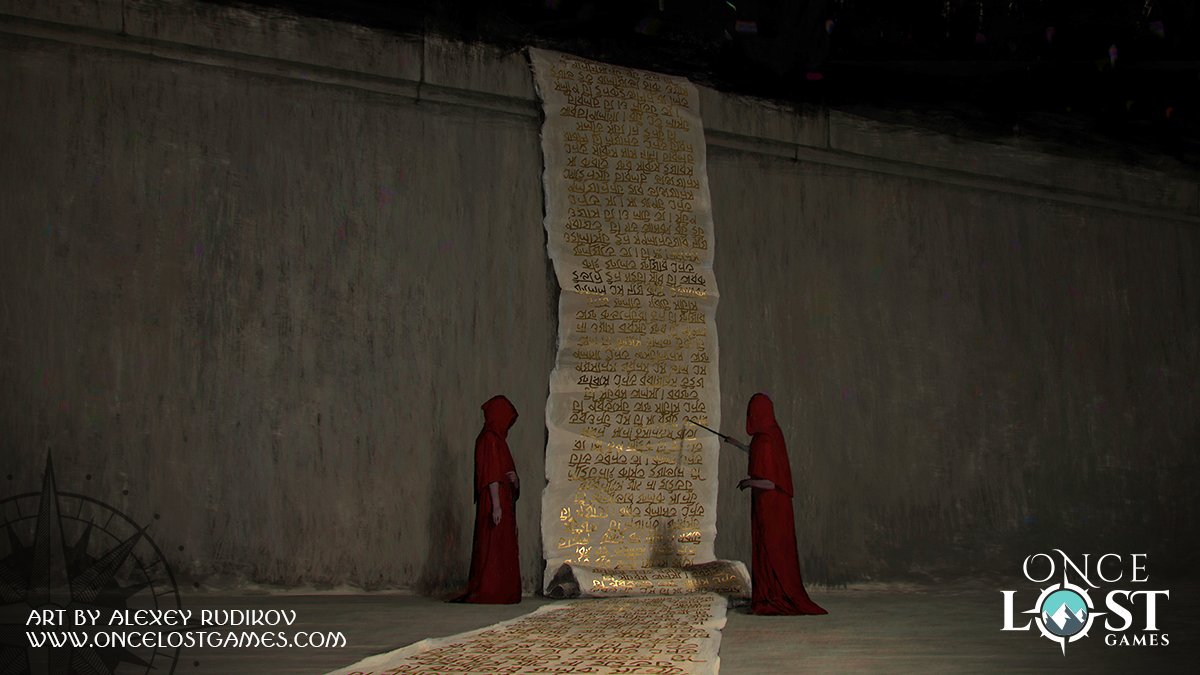Julian LeFay, Ted Peterson and Vijay Lakshman.
https://www.youtube.com/watch?v=mMdyX0--eaA
http://www.oncelostgames.com/
Quotes from interviews:
"We've been calling our system dynamic composition which is basically procedural generation done right. We definitely recognize the flaws in the system we created 25 years ago for Daggerfall but with a little wisdom and some technological advances, we shouldn't repeat the same mistakes … though we might make some new ones!"
"One thing I find useful in thinking about dynamic composition in general, from NPCs to towns to dungeons, is to think in terms of "seeds" and "sub-seeds." For example, the seed may be an underground city type dungeon, which comes with certain architectural elements, texture sets, monster encounters, quests, etc and a possibility of certain "sub-seeds," like bandits hangout, vampire's crypt, basically any secondary use the structure also contains. That helps create a history around the site, from its origin as a town that was buried in a volcanic eruption to it later being discovered and inhabited by a forbidden cult forced to go literally underground by authorities."
"Yes. I am calling it dynamic generation not procedurally generated. A lot will be hand created (as it was in Daggerfall) but the code will fill in the blanks for terrain, architecture, NPCs, quests, etc"
"Dynamic" is our term, not "radiant," fwiw. It's not so binary between dynamic and fixed. Hard to explain without spoilers. I guess the plainest way to put it is there aren't any quests that won't be altered at least somewhat by things like the player's reputation with the quest giver, world and local situations, etc"
"nonlinear and branching endless quests, which evolve the world, like a great virtual gamemaster running a pen-and-paper campaign”"
"You want characters that make sense but aren’t necessarily predictable, because that’s boring. That’s a pretty important thing to grasp when designing storylines and AI, particularly in a dynamically created, non-scripted adventure."
"Real substance and depth to it, add persistence where the game learns, put in learning algorithms and neural network, where the game adapts to how you act - 'It can be done'"
https://www.youtube.com/watch?v=mMdyX0--eaA
http://www.oncelostgames.com/
Quotes from interviews:
"We've been calling our system dynamic composition which is basically procedural generation done right. We definitely recognize the flaws in the system we created 25 years ago for Daggerfall but with a little wisdom and some technological advances, we shouldn't repeat the same mistakes … though we might make some new ones!"
"One thing I find useful in thinking about dynamic composition in general, from NPCs to towns to dungeons, is to think in terms of "seeds" and "sub-seeds." For example, the seed may be an underground city type dungeon, which comes with certain architectural elements, texture sets, monster encounters, quests, etc and a possibility of certain "sub-seeds," like bandits hangout, vampire's crypt, basically any secondary use the structure also contains. That helps create a history around the site, from its origin as a town that was buried in a volcanic eruption to it later being discovered and inhabited by a forbidden cult forced to go literally underground by authorities."
"Yes. I am calling it dynamic generation not procedurally generated. A lot will be hand created (as it was in Daggerfall) but the code will fill in the blanks for terrain, architecture, NPCs, quests, etc"
"Dynamic" is our term, not "radiant," fwiw. It's not so binary between dynamic and fixed. Hard to explain without spoilers. I guess the plainest way to put it is there aren't any quests that won't be altered at least somewhat by things like the player's reputation with the quest giver, world and local situations, etc"
"nonlinear and branching endless quests, which evolve the world, like a great virtual gamemaster running a pen-and-paper campaign”"
"You want characters that make sense but aren’t necessarily predictable, because that’s boring. That’s a pretty important thing to grasp when designing storylines and AI, particularly in a dynamically created, non-scripted adventure."
"Real substance and depth to it, add persistence where the game learns, put in learning algorithms and neural network, where the game adapts to how you act - 'It can be done'"


